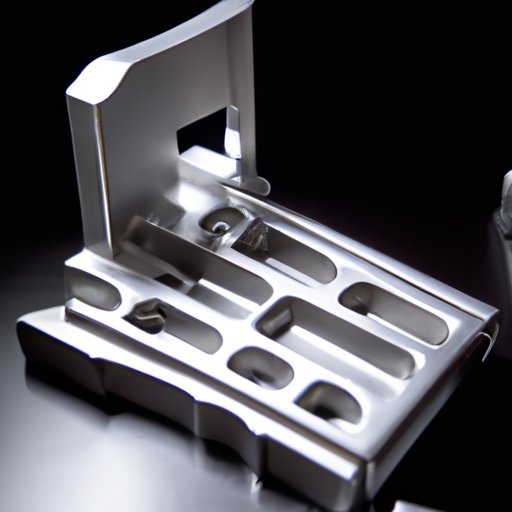Introduction
Die casting is a widespread manufacturing process used to produce metal products in high volume. While several metals can be used for this purpose, aluminum is a highly popular choice. In this article, we will take an in-depth look at die cast aluminum, how it’s made, its benefits and drawbacks, and its applications. We will also explore emerging trends and sustainable practices in the industry.
A Beginner’s Guide to Understanding Die Cast Aluminum: Everything You Need to Know
Die cast aluminum is a manufacturing process in which molten aluminum is injected into a mold under high pressure. The mold contains a cavity that shapes the aluminum into the desired part. This process is highly efficient, allowing for fast-paced, precise, and cost-effective manufacturing.
The molten aluminum used in the die casting process is encased in a furnace and heated to a high temperature before being injected into the mold. The aluminum quickly cools and hardens, resulting in a high-strength, low-weight, and durable metal.
The benefits of using die cast aluminum include its lightweight, high strength-to-weight ratio, excellent thermal conductivity, and corrosion resistance. Additionally, die cast aluminum is easily customizable, recyclable, and can enhance precision and quality control in production.
Common applications of die cast aluminum include automotive parts, electrical and plumbing fixtures, hand-held tools, and consumer goods such as toys, cameras, and appliances.

The Pros and Cons of Using Die Cast Aluminum in Manufacturing
Like any manufacturing process, die casting with aluminum has its pros and cons. While the benefits of using die cast aluminum are notable, there are some drawbacks to consider, such as the initial cost of tooling and molds, the need for high-pressure machines, and potential porosity in the finished product.
One factor that manufacturers must consider when choosing to incorporate die cast aluminum into their production process is cost. Because of the high cost of tooling, die cast aluminum is best suited for high-volume production runs. However, the low cost of aluminum itself and the efficiency of the die casting process can offset initial tooling costs. Additionally, the lightweight and high durability of die cast aluminum can provide long-term cost savings.
Another factor to consider is the ease of use. Because die casting is such a precise process, it requires specific molds and machinery to create the desired product. However, once the molds are created, the manufacturing process can be highly automated and cost-effective.

The Future of Die Cast Aluminum: New Trends and Developments to Watch
The world of die cast aluminum is continually evolving, with exciting new trends and developments shaking up the industry. One emerging trend is the use of meltless technologies, which eliminates the need for melting aluminum in a furnace, reducing energy consumption and carbon emissions.
Another promising development is the use of artificial intelligence in die casting processes. AI can help manufacturers predict and prevent defects and optimize production processes for greater efficiency and quality control.
New materials such as composites, ceramics, and magnesium alloys are being increasingly used in die casting, providing new possibilities for high-performance parts with greater strength-to-weight ratios.
How Die Cast Aluminum is Revolutionizing Automotive Manufacturing
The automotive industry has long relied on die cast aluminum for components such as engine blocks, wheels, and transmission housings. Die cast aluminum can withstand high temperatures, is durable in harsh environments, and helps to make vehicles lighter, more fuel-efficient, and safer.
For example, die cast aluminum parts can replace steel parts, reducing vehicle weight and improving fuel efficiency. Such parts can also provide better corrosion resistance, improved noise reduction, and more aesthetic design possibilities.
The Sustainability Benefits of Using Die Cast Aluminum: An Eco-Friendly Manufacturing Choice
Die cast aluminum is highly sustainable and eco-friendly. The aluminum used in die casting is recycled and reused, reducing waste and environmental impact. Additionally, die cast aluminum has a low carbon footprint, making it an increasingly popular choice among sustainability-minded manufacturers.
Manufacturers can also incorporate sustainable practices and materials into their die casting processes, such as using renewable energy sources and non-toxic coatings.
Conclusion
In summary, die cast aluminum is a critical manufacturing process that offers significant benefits to a wide range of industries. Its strength, durability, and lightweight properties make it a versatile metal with numerous applications. As the industry continues to evolve and innovate, so too will the potential for new uses and greater sustainability in the use of die cast aluminum.
Understanding die cast aluminum and incorporating sustainable practices into its production can support a more efficient and eco-friendly manufacturing industry, while also providing high-quality, cost-effective products to consumers worldwide.

